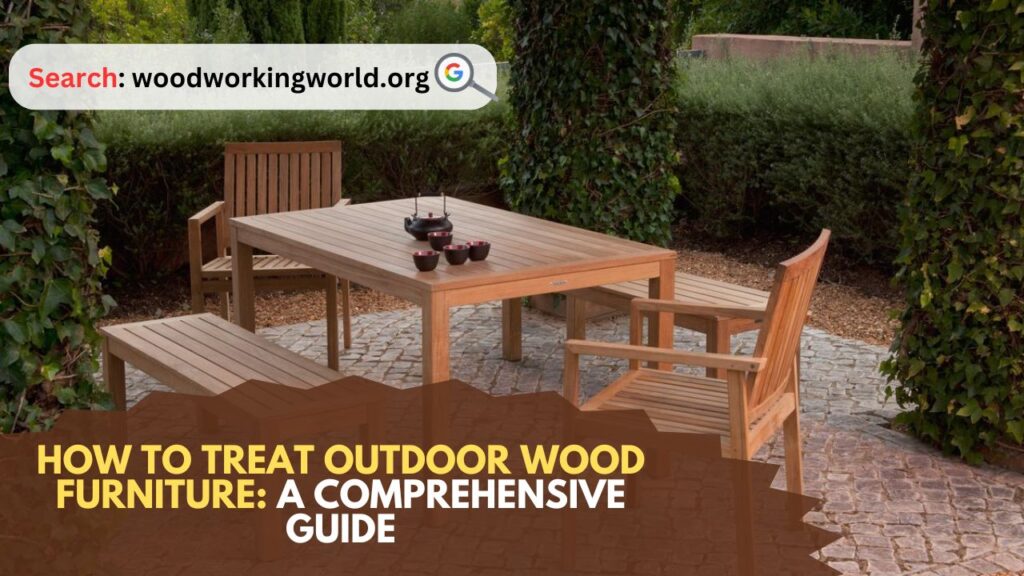Extend the life and beauty of your outdoor space! Learn how to treat outdoor wood furniture with our easy guide. Discover the best cleaning methods, stains, and sealants to protect your furniture from harsh weather and keep it looking beautiful for years to come.
How to Treat Outdoor Wood Furniture: Outdoor wood furniture can enhance the beauty and functionality of your garden, patio, or balcony. However, it requires proper care and maintenance to withstand the elements and last for years. This comprehensive guide will walk you through the steps on how to treat outdoor wood furniture and protect your outdoor wood furniture, ensuring it remains attractive and durable.

How to Treat Outdoor Wood Furniture
Understanding Wood Types
Before diving into treatment methods, it’s essential to understand the type of wood your furniture is made of, as different woods have varying levels of resistance to weather and decay. Common types of wood used for outdoor furniture include:
- Teak: Naturally resistant to water and decay, teak is one of the most durable woods for outdoor furniture. It has a high oil content, making it less susceptible to moisture and pests.
- Cedar: Known for its natural resistance to insects and decay, cedar is a lightweight and aromatic wood. It requires regular maintenance to keep its appearance and longevity.
- Redwood: Similar to cedar, redwood is resistant to decay and insects. Its rich color and durability make it a popular choice for outdoor furniture.
- Pine: Treated pine can be used for outdoor furniture, but it requires more maintenance compared to naturally resistant woods like teak or cedar.
- Eucalyptus: This hardwood is a more affordable alternative to teak. It is resistant to decay and insects but needs regular oiling to maintain its appearance.
Cleaning Your Outdoor Wood Furniture
Before applying any treatments, it’s crucial to clean your outdoor wood furniture thoroughly. Dirt, grime, and mildew can accumulate over time, affecting the wood’s appearance and performance.
- Gather Supplies:
- Mild detergent
- Soft brush or sponge
- Garden hose
- Sandpaper (optional)
- Remove Loose Dirt and Debris:
- Use a soft brush or a dry cloth to remove any loose dirt or debris from the surface of the furniture.
- Prepare a Cleaning Solution:
- Mix a small amount of mild detergent with warm water in a bucket. Avoid using harsh chemicals or bleach, as they can damage the wood.
- Scrub the Furniture:
- Dip a soft brush or sponge into the soapy water and gently scrub the furniture’s surface. Pay special attention to areas with stains or mildew.
- Rinse Thoroughly:
- Use a garden hose to rinse off the soap and dirt. Ensure all soap residue is removed to prevent any potential damage to the wood.
- Dry Completely:
- Allow the furniture to air dry completely. If the wood feels rough after drying, lightly sand the surface with fine-grit sandpaper to smooth it out.
Treating and Protecting Outdoor Wood Furniture
Once your outdoor wood furniture is clean and dry, it’s time to apply treatments that will protect it from the elements. The following steps outline the treatment process:
- Choosing the Right Treatment The type of treatment you choose depends on the wood type and your desired finish. Common treatments include:
- Oil: Penetrates the wood and enhances its natural beauty. Suitable for teak, eucalyptus, and other hardwoods.
- Sealant: Provides a protective layer that repels water and prevents moisture damage.
- Stain: Adds color to the wood while also providing protection against UV rays and moisture.
- Paint: Offers the most extensive protection but may require more maintenance over time.
- Applying Wood Oil Wood oil, such as teak oil or linseed oil, nourishes the wood and enhances its natural appearance.
- Gather Supplies:
- Wood oil
- Clean cloth or brush
- Gloves
- Apply the Oil:
- Using a clean cloth or brush, apply the oil evenly to the wood’s surface. Work in the direction of the wood grain for the best results.
- Allow the oil to penetrate the wood for the recommended time specified on the product label.
- Wipe Off Excess Oil:
- After the oil has soaked in, use a clean cloth to wipe off any excess oil. This prevents a sticky residue from forming on the surface.
- Repeat as Necessary:
- Depending on the wood type and condition, you may need to apply multiple coats of oil. Follow the product instructions for the best results.
- Applying Sealant A sealant creates a protective barrier that repels water and prevents moisture damage.
- Gather Supplies:
- Wood sealant
- Paintbrush or sprayer
- Sandpaper (optional)
- Prepare the Surface:
- If the wood feels rough, lightly sand it with fine-grit sandpaper to create a smooth surface.
- Apply the Sealant:
- Using a paint brush or sprayer, apply an even coat of sealant to the wood. Ensure all surfaces, including the undersides and crevices, are covered.
- Allow the sealant to dry according to the manufacturer’s instructions.
- Apply Additional Coats:
- For maximum protection, apply multiple coats of sealant. Follow the drying time recommendations between coats.
- Applying Wood Stain Wood stain adds color and enhances the wood’s natural grain while providing protection against UV rays and moisture.
- Gather Supplies:
- Wood stain
- Paintbrush or cloth
- Gloves
- Apply the Stain:
- Using a paintbrush or cloth, apply the stain evenly to the wood. Work in the direction of the wood grain.
- Allow the stain to penetrate the wood for the recommended time specified on the product label.
- Wipe Off Excess Stain:
- After the stain has soaked in, use a clean cloth to wipe off any excess stain.
- Apply Additional Coats:
- If desired, apply additional coats of stain for a deeper color. Follow the drying time recommendations between coats.
- Applying Paint Painting outdoor wood furniture provides the most extensive protection but may require more maintenance over time.
- Gather Supplies:
- Exterior paint
- Primer (if needed)
- Paintbrush or sprayer
- Sandpaper (optional)
- Prepare the Surface:
- If the wood feels rough, lightly sand it with fine-grit sandpaper to create a smooth surface.
- Apply a primer if the wood has not been previously painted. This helps the paint adhere better and provides a uniform finish.
- Apply the Paint:
- Using a paint brush or sprayer, apply an even coat of paint to the wood. Ensure all surfaces, including the undersides and crevices, are covered.
- Allow the paint to dry according to the manufacturer’s instructions.
- Apply Additional Coats:
- For maximum protection and a uniform finish, apply multiple coats of paint. Follow the drying time recommendations between coats.
Regular Maintenance Tips
In addition to the initial treatment, regular maintenance is crucial to keep your outdoor wood furniture in excellent condition. Here are some maintenance tips to follow:
- Clean Regularly:
- Remove dirt and debris from your furniture regularly using a soft brush or cloth. Clean with mild soap and water as needed.
- Inspect for Damage:
- Regularly inspect your furniture for any signs of damage, such as cracks, splits, or loose joints. Address any issues promptly to prevent further damage.
- Reapply Treatments:
- Depending on the type of treatment used, you may need to reapply oil, sealant, stain, or paint periodically. Follow the manufacturer’s recommendations for reapplication intervals.
- Protect from Harsh Weather:
- During extreme weather conditions, such as heavy rain, snow, or intense sunlight, consider covering your furniture or moving it to a sheltered area. This helps prolong its lifespan and maintain its appearance.
- Use Furniture Covers:
- Invest in high-quality furniture covers to protect your outdoor wood furniture when not in use. Covers shield the furniture from dirt, moisture, and UV rays.
- Store During Off-Season:
- If you live in an area with harsh winters, consider storing your outdoor wood furniture indoors during the off-season. This prevents damage from freezing temperatures and moisture.
Conclusion: How to Treat Outdoor Wood Furniture
How to Treat Outdoor Wood Furniture: Properly treating and maintaining your outdoor wood furniture is essential for preserving its beauty and longevity. By understanding the type of wood, cleaning it thoroughly, and applying the appropriate treatments, you can ensure your furniture withstands the elements and remains a cherished part of your outdoor space for years to come. Regular maintenance and protective measures will further extend the life of your outdoor wood furniture, allowing you to enjoy its comfort and aesthetic appeal in every season.
I hope this article on How to Treat Outdoor Wood Furniture has been helpful. If you have any further questions, please feel free to leave a comment below.
Video

